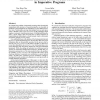Free Online Productivity Tools
i2Speak
i2Symbol
i2OCR
iTex2Img
iWeb2Print
iWeb2Shot
i2Type
iPdf2Split
iPdf2Merge
i2Bopomofo
i2Arabic
i2Style
i2Image
i2PDF
iLatex2Rtf
Sci2ools
PLDI
2015
ACM
2015
ACM
Automatic induction proofs of data-structures in imperative programs
We consider the problem of automated reasoning about dynamically manipulated data structures. Essential properties are encoded as predicates whose definitions are formalized via user-defined recursive rules. Traditionally, proving relationships between such properties is limited to the unfold-and-match (U+M) paradigm which employs systematic transformation steps of folding/unfolding the rules. A proof, using U+M, succeeds when we find a sequence of transformations that produces a final formula which is obviously provable by simply matching terms. Our contribution here is the addition of the fundamental principle of induction to this automated process. We first show that some proof obligations that are dynamically generated in the process can be used as induction hypotheses in the future, and then we show how to use these hypotheses in an induction step which generates a new proof obligation aside from those obtained by using the fold/unfold operations. While the adding of inducti...
Related Content
| Added | 16 Apr 2016 |
| Updated | 16 Apr 2016 |
| Type | Journal |
| Year | 2015 |
| Where | PLDI |
| Authors | Duc-Hiep Chu, Joxan Jaffar, Minh-Thai Trinh |
Comments (0)

